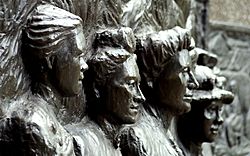Kate Sheppard National Memorial facts for kids
Quick facts for kids Kate Sheppard National Memorial |
|
|---|---|

Close up of the memorial
|
|
| Artist | Margriet Windhausen |
| Year | 1993 |
| Type | Stone and bronze |
| Dimensions | 2.1 m × 5 m (6.9 ft × 16 ft) |
| Location | Christchurch, New Zealand |
| 43°31′50.09″S 172°38′0.7″E / 43.5305806°S 172.633528°E | |
The Kate Sheppard National Memorial in Christchurch, New Zealand, is a special monument. It was built to remember the important fight for women's right to vote. It especially honors Kate Sheppard, who was a main leader in this movement.
Contents
About the Kate Sheppard Memorial
The idea for this memorial came up in 1989. People wanted to celebrate the 100th anniversary of women getting the right to vote in New Zealand. This anniversary was going to happen in 1993.
A group was formed to choose a design for the memorial. They picked the design by Margriet Windhausen. She is an artist from the Netherlands who lives in New Zealand.
What Does the Memorial Look Like?
The memorial is a stone wall. It has a life-size bronze sculpture of Kate Sheppard and five other important women. These women were leaders in the fight for women's voting rights.
On both sides of the sculpture, there are panels. These panels show scenes of what everyday women's lives were like in the late 1800s. They also have text that tells the story of the struggle for women's right to vote. The whole memorial is about 5 meters (16 feet) wide and 2 meters (6.5 feet) tall.
The Women in the Sculpture
The sculpture shows a group of women. They are carrying their petition (a formal request) for women's right to vote. They are taking it to Parliament in a wooden cart.
The women shown in the sculpture are (from left to right):
- Helen Nicol: She was a women's suffrage campaigner from Dunedin.
- Kate Sheppard: A key leader for women's voting rights.
- Ada Wells: She worked hard to improve education for girls.
- Harriet Morison: She helped working women and was also from Dunedin.
- Meri Mangakāhia: She was a Māori leader from Te Tai Tokerau. She asked Te Kotahitanga (the Māori parliament) to give women the right to vote.
- Amey Daldy: She was part of the Auckland Woman's Christian Temperance Union.
Unveiling the Memorial
The memorial was officially revealed on 19 September 1993. This date was exactly 100 years after women in New Zealand got the right to vote. Dame Catherine Tizard, who was the Governor-General of New Zealand at the time, unveiled it.
A time capsule was placed inside the monument. It holds news articles and information about women's lives from 1993.
Where to Find It
The memorial is in a special park called the Kate Sheppard National Memorial Reserve. It is next to the Avon River. It's also near a historic building called Our City (which used to be the Old Municipal Chambers). This spot is close to the corner of Worcester Street and Oxford Terrace.
The building next to the memorial was damaged in the 2010 Canterbury earthquake. Because of this, the memorial was behind fences for a while. In June 2014, the fences were removed. The Mayor of Christchurch, Lianne Dalziel, led a ceremony to reopen public access to the memorial.


